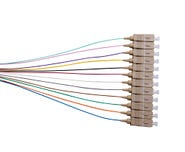

What are fibre optic pigtails?
Fibre optic pigtails are a common solution for fibre cable termination. Fibre cable termination refers to terminating connectors to individual optical fibres within a cable. The fibres require connectors to be attached before they can connect to other equipment. In this post, we will take a detailed look at fibre optic pigtails.
What is a fibre optic pigtail?
A fibre optic pigtail is a short, single fibre optical cable that contains a factory-installed optical connector on one end. The end of the pigtail is fusion spliced to a single fibre contained within the multi-fibre cable. The individual fibres of the multi-fibre cable are used to connect to the end equipment.
What is the application of a fibre optic pigtail?
Fibre optic pigtails are commonly found in fibre optic management equipment, such as distribution boxes, fibre terminal boxes, and all other fibre enclosure products. Pigtails are popular across both single-mode and multimode applications.
How to choose fibre optic pigtails
There are various types of fibre optic pigtails available in the market, and each has a specific application. Fibre pigtails are classified according to their fibre grade and connector type.
There are two types of pigtails available: single-mode fibre pigtails and multimode fibre pigtails. Single-mode fibre pigtails use single-mode 9/125 micron fibre cables and Multimode fibre pigtails use 50/125 micron or 62.5/125 micron fibre cables. They can be further classified based on their optical properties. Pigtails can be classified as OM1 fibre, OM2 fibre, OM3 fibre, and OM4 fibre.
Fibre optic pigtails can also be classified by the connector type. Common connector types include SC, SCA, LC, LCA, ST, and more. They all have their own particular applications and advantages.
Common types of pigtails
Based on the application environment, you may need a pigtail with added features. There are special pigtails made to undergo harsh and extreme weather conditions and therefore have extra protection. These include waterproof fibre optic pigtails and armoured fibre optic pigtails.
Fibre optic pigtails can also be classified by fibre count. Pigtails will typically have a fibre count of 1, 2, 6, 12 or 24 strands. While the simplex fibre optic pigtail has one fibre count and one connector at the end, the duplex fibre optic pigtail has a fibre count of two and hence has two connectors at one end, and so on.
Recent Articles

Test Network Cabling & Patch Cords FAST with the New DATATESTER by CABAC
Testing LAN cables is quick and easy when you’ve got the new CABAC DATATESTER on hand. This budget LAN cable tester is perfect for contractors who need to test data and coaxial cable for correct termination.
View Products
Exploring the Advantages of Thin Patch Leads
For Australian data installers, selecting the right network components is critical to achieving the performance and reliability that your customers expect. Among these components, the humble patch lead plays a crucial role in interconnecting various devices.
View Products
FOBOT Buying Guide
In this informative article, we will provide a basic buying guide for FOBOTs or “Fibre Optic Break Out Trays” so that you can choose the right product for your specific needs.
View Products
What is a FOBOT?
In this article, we will explain what a FOBOT is and where they are used. We will also describe how a FOBOT works and the important role this component plays in managing and distributing optical fibres efficiently. So, if you're looking to learn all about FOBOTs, make sure to read this article...
View Products
What is the difference between OS1 and OS2 Singlemode Optical Fibre?
This technical article delves into the differences between OS1 and OS2 Singlemode fibre optics, including their core characteristics, performance specifications, and ideal applications.
View Products




















